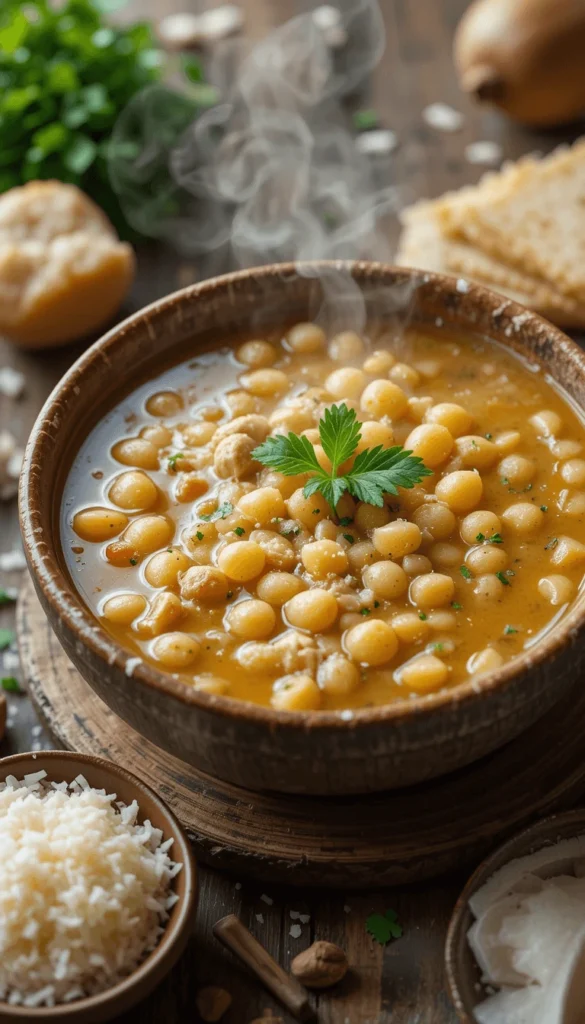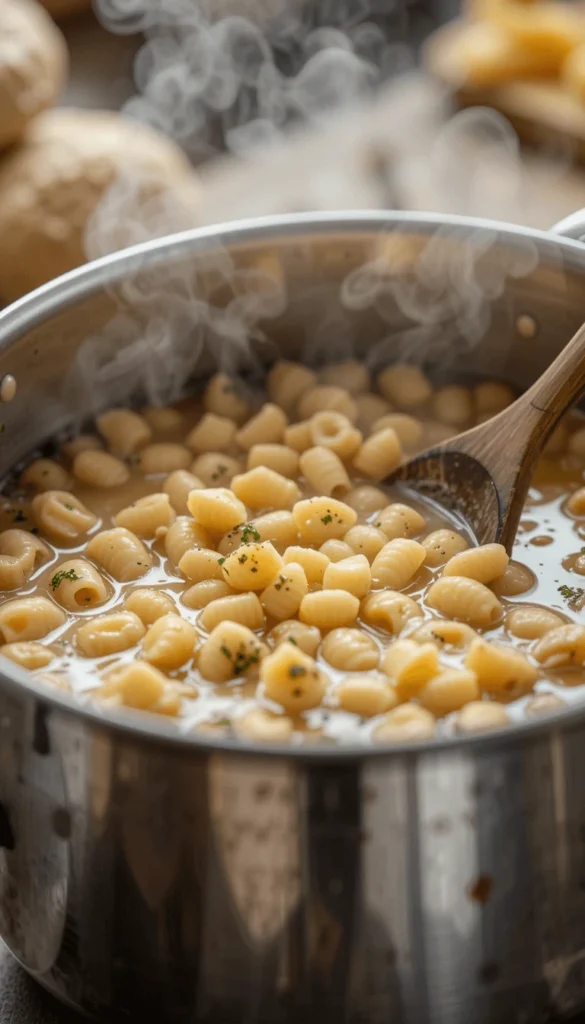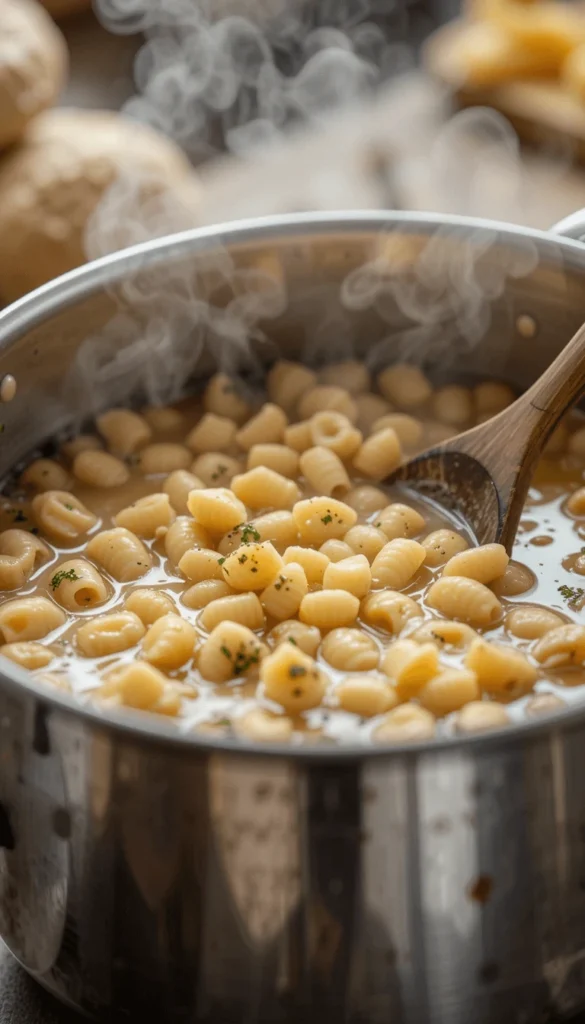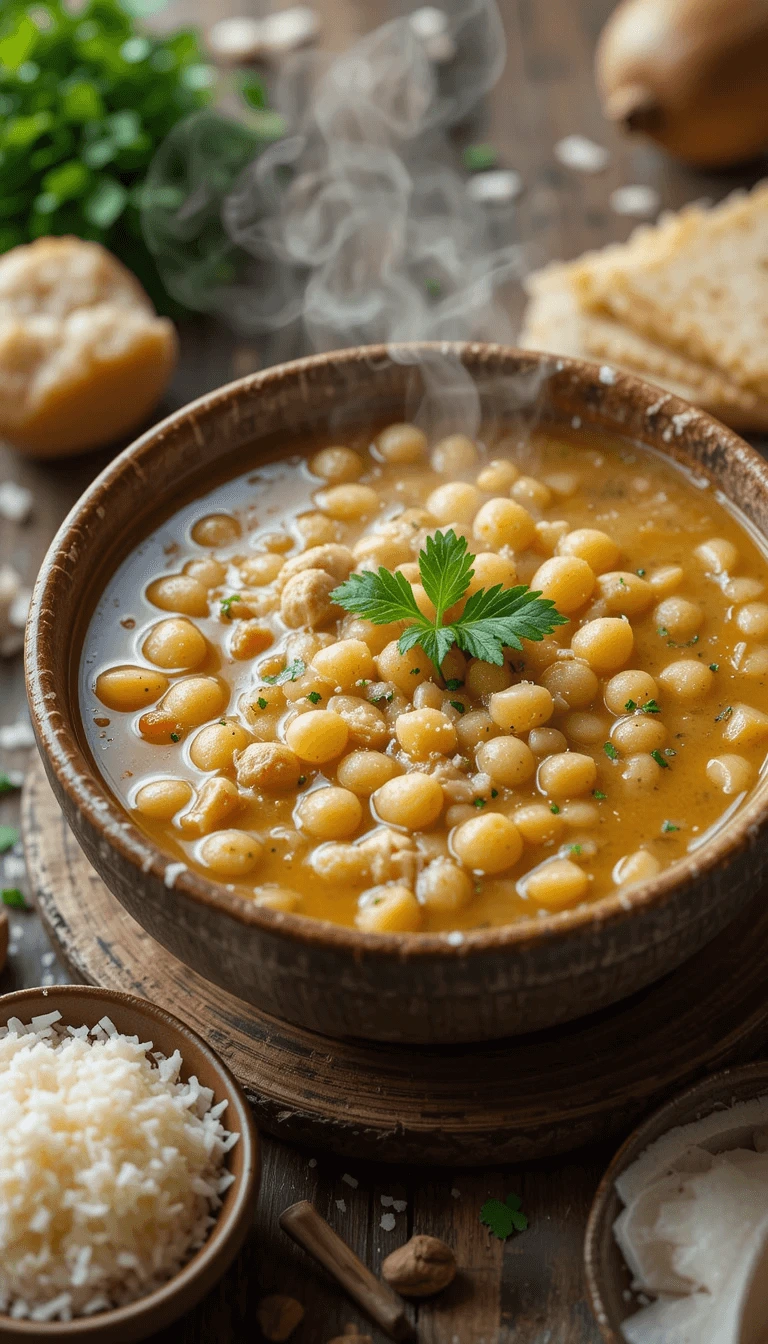There’s something deeply comforting about a bowl of Italian Pastina Soup. It’s not just a recipe — it’s a memory, a feeling, and for many, a taste of home. Whether served to soothe a cold, calm a busy day, or fill a hungry belly with warmth, pastina soup has always held a special place at the heart of Italian kitchens.
This soup is known for its simplicity — tiny pasta stars (pastina) swimming in a savory broth, often enriched with a sprinkle of Parmesan cheese and finished with a drizzle of olive oil or a touch of butter. It’s gentle, nourishing, and perfect for both kids and adults. For many Italians, it’s the first “real” food served in childhood and a go-to remedy in adulthood. It’s the kind of dish a Nonna makes without a recipe — just love and a ladle.
What makes this version the best? It’s incredibly easy to make, uses just a few wholesome ingredients, and comes together in under 30 minutes. No fancy techniques or hard-to-find ingredients — just real, cozy food that soothes from the inside out.
Whether you’re new to pastina or it’s part of your family tradition, this simple, soul-warming recipe is about to become a favorite in your home. Let’s dive into the many reasons this dish deserves a regular spot in your weekly meal plan.

Key Benefits of This Italian Pastina Soup Recipe
This isn’t just any soup. It’s a deeply satisfying, feel-good dish with practical benefits that make it a standout choice for everyday cooking. Here’s why you’ll keep coming back to this Italian Pastina Soup recipe again and again:
1. Quick and Easy – Ready in 30 Minutes or Less
No need to plan ahead or spend hours in the kitchen. This soup comes together fast, with minimal prep and just one pot. It’s ideal for busy weeknights, last-minute meals, or days when you just need something warm and soothing — fast.
2. Uses Simple, Pantry-Staple Ingredients
This recipe doesn’t require a long shopping list. All you need are basic ingredients like pastina, broth, Parmesan, and olive oil. Chances are, you already have everything in your kitchen. It’s budget-friendly, practical, and always accessible.
3. Comforting and Kid-Friendly
With its soft texture and mild flavor, pastina soup is incredibly easy to digest. It’s perfect for toddlers, picky eaters, and even those feeling under the weather. It’s gentle, yet satisfying — the ultimate comfort food for all ages.
4. Versatile and Customizable
This recipe is a beautiful base. Want more protein? Add shredded chicken or a whisked egg. Craving veggies? Toss in spinach, carrots, or peas. You can dress it up or keep it simple. It adapts to your needs and what’s in your fridge.
5. Healing and Nourishing
Traditionally served when someone is sick or run down, this soup is light yet full of nutrients. The warm broth hydrates, while the pastina provides gentle energy. It’s a dish that feels like a hug — perfect for recovery days or just when you need a little warmth.
6. One-Pot Convenience = Easy Cleanup
Less mess, fewer dishes. You make everything in one pot, which means faster cleanup and a more relaxed cooking experience.
7. A Taste of Italian Heritage
For many families, this dish carries strong roots and beautiful memories. It’s a way to reconnect with tradition or explore authentic Italian flavors in a very approachable way. Even if you didn’t grow up with pastina, it can still become your family tradition.
Ingredients for the Best Italian Pastina Soup
One of the biggest reasons this pastina soup is so loved? Simplicity. It doesn’t rely on hard-to-find ingredients or complicated prep — just humble, wholesome items that work together to create something truly comforting.
Here’s what you’ll need to make a traditional, soul-warming bowl of Italian pastina soup:
Basic Ingredients:
- ¾ cup pastina pasta (or any tiny pasta like stelline, acini di pepe, or orzo)
- 4 cups chicken broth or vegetable broth (low-sodium for more control)
- 1 tablespoon unsalted butter or 1 tablespoon olive oil
- 2 tablespoons grated Parmesan cheese, plus more for serving
- Salt and freshly ground black pepper, to taste
Optional Flavor Boosters:
- 1 small garlic clove, minced (for a subtle aromatic layer)
- ¼ small onion, finely chopped (sautéed at the beginning for depth)
- 1 egg, beaten (stirred in to create egg ribbons like in stracciatella)
- Fresh parsley, chopped (for garnish and a fresh finish)
Add-Ins (Optional for Variations):
- Cooked, shredded chicken (for protein and heartiness)
- Baby spinach or peas (for added nutrition and color)
- A splash of lemon juice (to brighten the flavor before serving)
Ingredient Notes:
- Pastina: If your store doesn’t carry pastina, tiny shapes like stelline, ditalini, or even broken spaghetti work beautifully.
- Broth: Homemade or high-quality store-bought broth adds richness. Choose low-sodium so you can season to taste.
- Butter vs. Olive Oil: Butter adds creaminess and richness, while olive oil lends a slightly earthy flavor. Either works — or use both for balance.
Ingredients for the Best Italian Pastina Soup
One of the biggest reasons this pastina soup is so loved? Simplicity. It doesn’t rely on hard-to-find ingredients or complicated prep — just humble, wholesome items that work together to create something truly comforting.
Here’s what you’ll need to make a traditional, soul-warming bowl of Italian pastina soup:
Basic Ingredients:
- ¾ cup pastina pasta (or any tiny pasta like stelline, acini di pepe, or orzo)
- 4 cups chicken broth or vegetable broth (low-sodium for more control)
- 1 tablespoon unsalted butter or 1 tablespoon olive oil
- 2 tablespoons grated Parmesan cheese, plus more for serving
- Salt and freshly ground black pepper, to taste
Optional Flavor Boosters:
- 1 small garlic clove, minced (for a subtle aromatic layer)
- ¼ small onion, finely chopped (sautéed at the beginning for depth)
- 1 egg, beaten (stirred in to create egg ribbons like in stracciatella)
- Fresh parsley, chopped (for garnish and a fresh finish)
Add-Ins (Optional for Variations):
- Cooked, shredded chicken (for protein and heartiness)
- Baby spinach or peas (for added nutrition and color)
- A splash of lemon juice (to brighten the flavor before serving)
Ingredient Notes:
- Pastina: If your store doesn’t carry pastina, tiny shapes like stelline, ditalini, or even broken spaghetti work beautifully.
- Broth: Homemade or high-quality store-bought broth adds richness. Choose low-sodium so you can season to taste.
- Butter vs. Olive Oil: Butter adds creaminess and richness, while olive oil lends a slightly earthy flavor. Either works — or use both for balance.
Instructions for Making the Best Italian Pastina Soup
Making Italian Pastina Soup is as simple as it gets, and it comes together in just a few easy steps. Whether you’re a seasoned cook or a beginner, you’ll find this recipe quick, straightforward, and comforting. Let’s get started!
Step 1: Prepare the Broth
In a large pot, bring your chicken broth (or vegetable broth) to a simmer over medium heat. Add a pinch of salt and a few cracks of black pepper to season. If you’re using onion or garlic for extra flavor, add them to the pot now and let them soften for 2-3 minutes before moving to the next step.
Step 2: Add the Pastina
Once the broth is simmering, add the pastina pasta. Stir it occasionally to prevent sticking. Allow the pastina to cook according to the package instructions, usually 4-6 minutes, until tender but still slightly firm. If you’re using egg for a creamier texture, beat it in a small bowl and slowly pour it into the soup while stirring to create delicate egg ribbons.
Step 3: Add Butter and Parmesan
When the pastina is cooked, stir in the butter (or olive oil) and grated Parmesan cheese. This will enrich the broth, creating a velvety smooth soup. Adjust the seasoning with more salt and pepper to taste.
Step 4: Serve and Garnish
Ladle the hot soup into bowls and garnish with a sprinkle of additional Parmesan cheese and a pinch of fresh parsley. Serve immediately while hot.
Additional Notes:
- For a richer soup, you can add a drizzle of olive oil or a dollop of butter right before serving.
- If you prefer a thicker soup, simply cook the pastina longer or add a bit more pasta.
- Want more texture? Add shredded chicken or spinach in the final few minutes of cooking.

Pro Tips and Variations
To take your Italian Pastina Soup from delicious to exceptional, here are some helpful tips and variations you can try. Whether you’re looking to enhance the flavor, add some extra nutrition, or customize the recipe to fit your needs, these ideas will give you plenty of options to make this soup your own.
Pro Tips for Perfecting Your Pastina Soup:
1. Use Homemade Broth for Maximum Flavor
While store-bought broth is convenient, homemade chicken or vegetable broth adds an extra layer of richness that’s hard to beat. If you have the time, making your own broth is the best way to elevate the flavor of the soup.
2. Don’t Overcook the Pastina
Pastina cooks quickly, so be sure to keep an eye on it. If it cooks too long, it can become mushy. Aim for a slightly al dente texture for the best result, with a little bite left in the pasta.
3. Add an Egg for Extra Creaminess
If you want a creamier soup, whisk an egg into the broth after the pastina is cooked. The heat from the soup will cook the egg, creating delicate ribbons of egg throughout. This adds richness and a silky texture to the soup.
4. Season in Layers
Add your seasoning gradually, tasting along the way. Begin with a pinch of salt in the broth and adjust as you go. This ensures the soup is perfectly seasoned without being too salty. Freshly ground black pepper, a dash of garlic powder, or a sprinkle of crushed red pepper flakes can also be used for extra depth.
5. Consider a Slow Simmer for Extra Flavor
If you have extra time, let the soup simmer on low heat for an additional 10-15 minutes. This allows the flavors to meld together, creating a richer, more complex broth.

Variations to Try:
1. Add Protein with Shredded Chicken
If you’re looking for more protein in your soup, add some shredded rotisserie chicken or cooked chicken breast during the last few minutes of cooking. The chicken will warm up and infuse the broth with flavor, making it even heartier.
2. Vegetarian or Vegan Version
For a plant-based twist, you can easily make the soup vegan. Simply use vegetable broth and substitute olive oil for the butter. You can also skip the Parmesan or use a vegan cheese alternative.
3. Boost the Greens
Add some greens to your soup to give it more nutrients. Try tossing in some baby spinach, kale, or peas in the last few minutes of cooking. Not only do these additions add color, but they also make the soup healthier.
4. Flavor Boosters
For a slightly tangy kick, add a splash of lemon juice right before serving. You can also experiment with different herbs, like oregano, basil, or thyme, to give the soup an Italian garden flavor. A sprinkle of Parmesan rind while the soup simmers can deepen the flavor as well.
5. Make it a Meal with Crusty Bread
Pair this soup with a side of rustic crusty bread for dipping. The bread soaks up the flavorful broth, making each bite even more satisfying.
Serving Suggestions for Italian Pastina Soup
This Italian Pastina Soup is perfect on its own, but with a few simple sides and additions, it can easily become a complete meal. Whether you’re serving it as a light lunch, a cozy dinner, or a nourishing dish for someone under the weather, here are a few ideas to make your meal even more satisfying.
1. Pair with Crusty Bread
A warm, crusty bread is the perfect companion for this soup. The bread soaks up the flavorful broth, making each bite feel more filling. Try a rustic sourdough or a baguette for the best texture.
2. Top with Extra Parmesan
A finishing touch of freshly grated Parmesan cheese brings an extra burst of flavor and richness. If you’re feeling indulgent, you can also add a drizzle of olive oil or a pat of butter for even more depth.
3. Serve with a Simple Salad
For a well-rounded meal, serve your soup with a simple green salad. A light salad with fresh greens, cherry tomatoes, and a lemon vinaigrette complements the warmth of the soup and adds a refreshing contrast.
4. Add Protein with a Side of Grilled Chicken
If you want to turn this soup into a more substantial meal, consider serving it with a side of grilled chicken breast or grilled shrimp. The protein will balance the lightness of the soup, turning it into a filling dinner.
5. Make It a Comforting Meal for Kids
For a kid-friendly twist, serve the soup with a side of grilled cheese sandwiches. The combination of warm soup and cheesy bread is a hit with children and adults alike.
6. Serve for Special Occasions
Though it’s simple, Italian Pastina Soup can also be served on special occasions, particularly when you want something light but satisfying. Whether it’s part of a family gathering or a solo treat, the soothing warmth of this soup is always appreciated.
Storing and Reheating:
If you have leftovers, this soup keeps well in the fridge for up to 3 days. The pastina will continue to absorb the broth, so you might need to add a bit more liquid when reheating. Simply warm it on the stove over low heat, adding a splash of broth or water as needed.
You can also freeze this soup, though the pastina may become softer upon reheating. To freeze, let the soup cool completely, then store it in an airtight container for up to 3 months.

Conclusion
There’s a reason Italian Pastina Soup has been a beloved comfort food for generations. Its simple ingredients, quick preparation, and heartwarming flavors make it an ideal dish for any occasion. Whether you’re craving a bowl of soul-soothing soup after a long day, need something light yet nourishing, or are looking for a recipe to share with loved ones, pastina soup checks all the boxes.
With just a few staple ingredients and a bit of love, you can create a meal that’s both comforting and satisfying. The versatility of this dish allows for endless variations, so you can customize it to your taste and dietary preferences. Plus, it’s easy to make, easy to store, and always guaranteed to bring a smile to your face.
So next time you’re in the mood for something simple, nutritious, and heartwarming, make this Italian Pastina Soup — your new go-to comfort food. You’ll see why it’s been a staple in Italian kitchens for generations, and why it’ll soon become a favorite in yours too.
FAQs (Past Your Questions Here)
Here are some of the most frequently asked questions about Italian Pastina Soup, along with answers to help you make the most of this classic recipe.
1. Can I use a different type of pasta if I can’t find pastina?
Yes, you can easily substitute pastina with small pasta shapes like stelline, orzo, acini di pepe, or ditalini. The key is to use small pasta that cooks quickly and easily absorbs the broth, giving you that comforting texture.
2. Can I make Italian Pastina Soup ahead of time?
Absolutely! You can make this soup in advance and store it in the fridge for up to 3 days. The pastina will absorb more of the broth as it sits, so you might need to add a little extra liquid when reheating. Simply heat it on the stove and add broth or water as needed.
3. Is it possible to freeze Italian Pastina Soup?
Yes, you can freeze the soup. Let it cool completely before storing it in an airtight container for up to 3 months. Keep in mind that the pastina may soften a bit when reheated. To reheat, warm it slowly on the stove with a splash of broth or water.
4. Can I make Italian Pastina Soup vegetarian or vegan?
Yes! For a vegetarian version, simply use vegetable broth instead of chicken broth and substitute olive oil for butter. To make it vegan, omit the Parmesan cheese or use a dairy-free alternative.
5. What’s the best way to make the broth rich and flavorful?
Using homemade broth or a high-quality store-bought option will give you the best flavor. If you’re using store-bought, go for low-sodium broth so you can control the seasoning. For extra flavor, you can also add herbs like rosemary or thyme, or simmer the broth with a Parmesan rind.
6. How can I make this soup more filling?
To make the soup more hearty, you can add protein such as shredded chicken or tofu. You can also toss in some vegetables like spinach, carrots, or peas to boost the nutrition. A slice of crusty bread on the side also makes it more filling.
7. What can I serve with Italian Pastina Soup?
Pastina soup pairs wonderfully with crusty bread, salads, or even grilled chicken for a more substantial meal. A simple green salad with lemon vinaigrette, or a side of grilled cheese, also complements the soup perfectly.
8. Can I add egg to the soup?
Yes! Adding a beaten egg to the soup creates a silky texture and delicate egg ribbons. It’s a traditional touch, often seen in Italian pastina soup recipes, and adds extra creaminess to the broth.
That wraps up the FAQs! Feel free to drop any more questions you may have, and I’ll be happy to answer them.
“If you loved this Italian Pastina Soup, check out our Soup Recipe for another hearty and comforting meal.”
“Want to learn more about the nutritional value of pastina? Check out the USDA’s guide for detailed info.”

